Marcia Thornton Jones's Blog, page 50
April 14, 2022
What puts a spring in your step? by: Jennifer Mitchell
What puts a Spring in my step?
This time of the year sometimes it is nice to reflect on what puts a spring in your step. After some reflection these are the things that make me happy.
-- when my students understand a new concept
-- when my students sing along to our class playlist
-- when a new trip to Disney is planned
-- when we have warm spring days in Missouri
(and I can get outside and enjoy them)
-- when I discover a new author that I love!
-- sharing poetry with kids that they love
-- when my students create their own poetry
-- taking my dogs on a walk
-- seeing flowers bloom
-- connecting with old friends
-- driving around in my Jeep with the top down
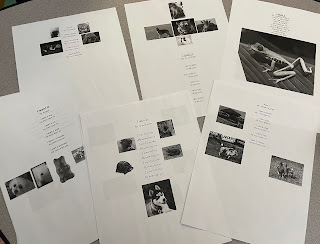 Poetry that second grade has been working on
Poetry that second grade has been working on
by: Jennifer Mitchell -- teacher in the Kansas City area
On the Fearlessness of Her Story
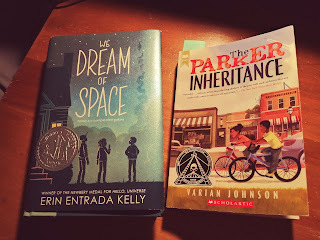
As we continue to explore the adventurous and fearlessness, I’ve long written about the heroine’s journey. In fact, both of my MGs – the historical fantasy Big River’s Daughter (Holiday House 2013), and the historical fiction, Girls of Gettysburg (Holiday House, 2014)—have explored plot movements of the heroine’s journey.
The protagonist of any story, the hero if you will, acts as a window inviting the reader into the story. The reader is drawn into the narrative because, just as the protagonist searches for their identity, the reader is engaged in their own search. Yet, if the hero is always male, and the journey is always his story, what recourse is left to young adult women and adolescent girls? What is her story? (An obvious question becomes, with the current movement toward LGBTQ representation, what is their hero’s journey? This discussion doesn’t address the specifics in the LGBTQ journey for identity, but hopefully someone more informed than I am will take up that call of action!)
The profound truth, and primary function, of adolescence is the separation from parent, the search for uniqueness and the triumphant integration into wholeness. It’s the essence of the archetypal hero’s journey. Every child looks for their own hero to identify with. Every reader seeks guides – protagonists – to show them how to begin their journey.
But that doesn’t mean their journey is the same. Even if the heroine’s journey follows a similar path, toward a similar purpose, there is a difference between his journey and her journey. (And by extension, their journey.)
Megan Leigh (Dispelling the Myth of Strong Female Characters) offers interesting insight into the “myth” of strong female characters. Among many stories (and movies) claiming to have strong female characters, one overriding issue seems to be distinguishing between strong and weak, and passive and active characters. A female who is caring, vulnerable, even emotional tends to be considered a weak character. Yet, a strong female who is aggressive, abrasive, even with difficulty connecting emotionally, is considered negative. Both types are flat, negating their own flawed, complex humanity. As such, both types are reduced to a stereotype. In contrast, male characters are often allowed to play the full emotive spectrum. Says Leigh, in too many stories, the strong female protagonist is considered “special,” the exception or chosen one. If only one woman is ever shown to be capable and complex, and is presented as the exception, the “very framing of the narrative in a way that has men writing off most females as incapable, is an issue unto itself.”
Tasha Robinson (We’re Losing All Our Strong Characters to Trinity Syndrome) considers Valka, the long lost mother of Hiccup in the movie How To Train Your Dragon 2. Valka is complicated, formidable, wise and damaged, and she is fully capable of taking care of herself. For decades she had successfully avoided capture and death at the hands of the bad guys. Yet, within minutes of coming onto the scene, she becomes suddenly inadequate and needs to be rescued – twice. And for the rest of the film, she does nothing except tell Hiccup that he is the chosen one. She has become superfluous.
Recently Harold Underdown (Executive Editor of Kane Press and owner of the website, Purple Crayon) recommended several books on his Facebook page (which he does every Friday. Check out his Facebook page, for his recommendations are terrific!).
The Dream of Space, by Erin Entrada Kelly (Greenwillow Books, 2020) presents a trio of protagonists, brothers Cash and Fitch, and sister Bird. Bird is my favorite for all the reasons noted above. She dreams of becoming NASA’s first female shuttle commander, but her ordeals include verbally abusive, even negligent parents, her wayward brothers, and a slew of misadventures in school. Her journey is set against the backdrop of the Challenger Shuttle disaster. The book is a great study in creating multidimensional characters that engage readers on the deepest, gut-wrenching level. It also illustrates the differences between narration (exposition/telling) and dramatization (showing).
Another recommendation is Varian Johnson’s The Parker Inheritance(Scholastic, 2018). A puzzle mystery, this is an intriguing study in viewpoint and the power of perception. Following her parent’s divorce, twelve-year old Candice and her mother move into her deceased grandmother’s house in Lambert, South Carolina. Struggling with her parent’s divorce, as well as the threat of poverty, Candice finds a mysterious letter addressed to her grandmother. The letter describes the Washington family, who were run out of Lambert during the turbulent 1950s. It also promises a fortune to anyone who can figure out the clues. The letter is her call to action. As she and her new friend Brandon decipher the clues, they discover not only the terrible secrets of the town haunted by its racially divided past, and the sad truth behind her grandmother’s destroyed reputation, they experience several instances of racism. This serves to motivate them all the more to find justice for the Washington family and her grandmother. Many chapters are told from the POV of other characters who lived in Lambert during the 1950s.
Returning to the mother of Hiccup, Valka. As an ancient symbol, the dragon (according to Jung) is “the wildness of spirit,” which escapes and destroys the artificial order of oppression. Valka, however, had her wings metaphorically clipped just as she was becoming interesting. How many characters have we followed that, in the end, have their wings clipped?
Both Bird and Candice remain fearless and engaging in their search for personal truth. In my own characters, I continue to explore the language, the ordeals and symbols that are uniquely her own, focusing on a fearless protagonist with her own identity, agenda and story purpose.
Who are your favorite strong female protagonists?
--Bobbi Miller
April 13, 2022
From Globetrotting Sleuths to Backyard Rangers: My Journey from YA to MG Mystery (Diana Renn)

My first three novels were YA mysteries featuring globetrotting teen sleuths, set in Japan, Ecuador, and Turkey. I also wrote a mystery for adults set in Egypt and Italy. International intrigue was fun to write. The research, though extensive, was fascinating.
While writing my adult novel, I was immersing myself in reading middle grade with my son, then in fourth grade. We were also fostering a clutch of turtle hatchlings for a local wildlife conservation group. An idea for a mystery of missing turtles hatched. I heard the main character’s voice and knew that this had to be a middle grade story. I wanted to stick with mystery, and wildlife crime fascinated me. But writing a middle grade mystery wasn’t as easy as I thought!
I did not want to sacrifice my character’s complex inner lives, though. Personal growth through the process of investigating a mystery was still important to me. In Trouble at Turtle Pond, I knew my main sleuth would have ADHD, and that he would need to learn about his strengths to heal a wound from his past. I wanted the readers to have plenty of access to his thoughts and feelings as he navigated new friendships in a new town. So I left that interior complexity intact, and found other places to streamline.
One place to simplify was geography. Miles and his fellow “Backyard Rangers” operate in about one square mile of territory: their street and an adjacent wildlife refuge, with occasional forays into the Marsh Hollow town center. They are bound to this small region by their lack of transportation and their parents’ rules. I thought this world might be too confining at first. However, I was pleasantly surprised to discover how big that world feels to them. At eleven, my characters are just starting to venture out of their yards and into areas where they are not entirely supervised. In one scene, Miles climbs an observation tower at the wildlife refuge and notes a warning sign about not leaving children unsupervised. “It feels great to be an unsupervised child!” he rejoices. Their world contains all the drama I need: intriguing suspects, nosy neighbors, odd goings-on at the pond, and turtles – lots of turtles. In addition, the kids operate a ranger station and lemonade stand out of a cardboard box, which draws new people to them, further broadening their world without their ever having to leave it.
"background: white; color: #222222; mso-highlight: white;">Another speed bump I hit was assuming young readers would track the mystery plot as easily as older readers. Some young readers of an early draft alerted me to potential confusion. Since middle grade readers are still relatively new to genre fiction, I therefore provided a bit of “mystery scaffolding” to guide them. This was easy to do since the four sleuths work together to pool information, frequently sharing what they know, don’t know, or still need to know. One character jots observations in a field journal. Another keeps a crime log and loves her lists. Miles, my main sleuth, teaches the others about means, motives, and opportunity, terms he’s gleaned from a cop show his parents watch. Additionally, I simplified the mystery plot by having only four suspects, and fewer plot twists.
I realized pretty quickly that I had to adjust the dials on the nature of the crime and the type of criminals I was dealing with. I didn’t want too much violence, but I did want to keep readers in suspense. I aimed for what adults might call “mild peril.” There are definitely some bad players afoot, and a couple of heart-pounding brushes with them. But unlike my YA or adult novels, no one is cornering people in dark alleys, or brandishing guns, or even laying a hand on a kid. A lot of the suspense comes from the child characters’ lack of full understanding of what they’re seeing. For example, the routine activities of field biologists setting nets in a pond and tracking nesting turtles at night with radio telemetry equipment can look scary, even sinister, in the dark, or from a distance. The imagination is a powerful thing, and I leaned heavily on it. I also leveraged one anxious character’s tendency toward catastrophic thinking. Scenes of physical danger had always drained me when writing my books for older readers, so I found it refreshing to keep the danger more at a distance, more suggestive and imagination-fueled than physically palpable.
My biggest learning curve was with voice. While learning to calibrate mysteries for younger readers, I had to hone the voice that had launched this novel, as the story was told in first person. The voice sputtered like a bad radio signal at first, but the more I connected with Miles’s emotional life, the more clearly I heard him. I did many revisions that were not focused on the mystery plot, but entirely on character and voice. I worked to eliminate observations or phrasing that seemed too teen or even too adult. So I was essentially learning on two levels as I wrote: how to write a middle grade mystery in particular, and how to write middle grade in general.
The speed bumps I hit were all instructive, and ultimately freeing, as I came to see the wonderful possibilities in writing mysteries for this age group. Now I’m hooked, hard at work on my second MG mystery . . . and having a smoother ride this time around because of all I’ve learned.
~

Diana Renn is the author of three YA mysteries featuring globetrotting teens: TOKYO HEIST, LATITUDE ZERO, and BLUE VOYAGE (all published by Viking / Penguin Random House). Closer to home, her new middle grade novel, TROUBLE AT TURTLE POND (Fitzroy Books / Regal House), was inspired by her volunteer work with Zoo New England’s turtle conservation program. Diana lives outside of Boston, and shares a street with turtles. Visit her online at dianarennbooks.com or on Instagram at @dianarennbooks.com.
April 12, 2022
SHADOW GRAVE: A New Novel by Author Marina Cohen
Since our April themes are fearlessness, adventurousness, impatience, and it is poetry month, I recently read a book that encompasses these categories in a different way. SHADOW GRAVE by Marina Cohen blends fearless with fearful, patience with impatience, adventurousness with wariness as to what unknown thing lurks in the shadows of our minds or in the night. And even though it is a novel written in prose, the descriptive language has a gothic and poetic quality. Cohen has a knack for setting a scene and making us feel like we are in the midst of something chilling and other-worldly.
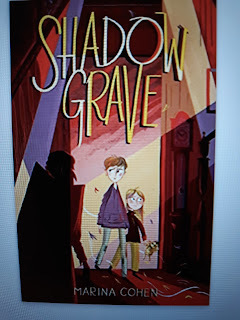
Here's the blurb for this spine-tingly novel:
Tuck Everlasting meets The Village in this delightfully eerie middle grade novel about a boy trapped in a strange town where secrets turn deadly and the unnatural lurks in the night.
Twelve-year-old Arlo is afraid of fire, creepy TV shows, and even his own shadow―but most of all, he’s afraid of losing his mother to the disease that nearly claimed her life a year ago.
During a Thanksgiving road trip, a sudden collision with a strange beast in the middle of the road totals the family’s car, and Arlo, his mom, and his sister end up stranded in a small town.
There’s something off about Livermore. No one has a phone or a car, and the townspeople aren’t exactly friendly. Without phone service to make a call for help, the family stays at the Samuels’ mansion, but inexplicable sightings at night set Arlo on edge. When he stumbles upon a dark secret that the town’s inhabitants will kill to keep, getting out of Livermore becomes a matter of life or death.
And here is my review:
“The moon hung like a silver pendant against the velvety black dress of night” is just one of the stunning images that pepper this spooky new middle grade novel from author Marina Cohen. It’s filled with vivid imagery and sensory details that pull you into the story. Cohen paints pictures with carefully chosen words that immerse the reader in the setting – the fictional New Hampshire town of Livermore. By turns ominous and thrilling, readers are compelled to keep reading even as you fear what lies around the corner. For anyone who loves a creepy well-told story.
Darlene Beck-Jacobson loves books with creepy vibes. She is often impatient, sometimes fearless, and always up for a new adventure. Her MG novel-in-verse WISHES, DARES, AND HOW TO STAND UP TO A BULLY (Creston) features characters who are all three.
April 11, 2022
Who, Exactly, Has the Quick Wit?
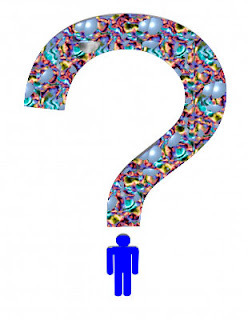
Considering the type of books I’ve written – 4 published with puzzles and a thriller coming out in August – my main characters need the smarts, the skills, the creativity, and the constitution to succeed in whatever I throw at them.
These characters may not be so quick witted from the start, but beyond chapter one, their positive qualities build and build until some point in the story, they say the right words and think the right thoughts and do all – or most – of the right things to bring about workable solutions and satisfying conclusions.
If only life were like that. If only, more often than not, I were smart enough to figure out the perfect answers in life. Sharp enough to see the details to untangle any messy web. Glib enough to utter a comeback that would send my antagonists whimpering.
If only I were that quick witted.
On the other hand, somewhere deep inside, I must be at least partly witted. Otherwise, I probably couldn’t write what I do.
Jody Feldman, author of the middle-grade books The Gollywhopper Games series and The Sevent Level (middle grade) somehow figured out how to get her main character out of trouble in her forthcoming YA thriller No Way Home (Sourcebooks; August 2, 2022). She’s still not sure how that happened.
April 10, 2022
What puts a spring in my step?
I've been visiting more bookstores lately. There is truly nothing that puts more spring in my step than a room full of books. Bookstores, libraries, classrooms full of books--just surround me with shelves and shelves of stories, and my heart is full. What's especially exciting these last few months is that sometimes, there's a book on the shelf that I wrote. There is nothing that makes my steps springier than running with my 6-year-old through a bookstore to find Mommy's book. And even better if the bookstore clerk offers to photo the moment.
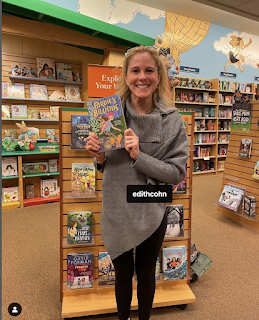
Authors know this is often a short-lived time in the life of a book. Shelf space is limited, and most books get a precious few months to exist on a bookstore shelf. Those months shortly after a book's release are an exciting time for an author.
Authors get a little longer on a library shelf. I moved houses recently, so I was thrilled to find BIRDIE'S BILLIONS on my new local library's shelf. I felt like I was being welcomed to the neighborhood.
If I'm feeling stuck writing-wise or down in the dumps, a library or a bookstore can always cheer me up. There's a great indie bookstore in NC called McIntyre's. I lived near this bookstore during my husband's cancer treatment. The good folks at McIntyre's have no idea how they saved me during this time. I'd walk into the store feeling lower than low and leave feeling like I could face another day.
Rooms full of books are pure magic. Don't you agree?
Edith Cohn is the author of middle grade mysteries BIRDIE'S BILLIONS and SPIRIT'S KEY. Learn more at http://edithcohn.com/
April 8, 2022
WANDERLUST -- by Jane Kelley
I have a STRONG desire to travel. That's why I became a writer. I wanted to experience more than one life had to offer.
And so I have flown with a flock of pigeons, outwitted a large black bear, haunted a house, cast out a demon, and eaten slimy tofu while hiking the Appalachian Trail.
I confess, I did those things while sitting at my desk.
Sometimes I do go on actual adventures. A few weeks ago, I visited the Kennedy Space Center in Florida. I saw many rockets and the Atlantis space shuttle and the actual room where engineers guided the astronauts to take their first step on the moon.

I also got to sit in a replica of the cockpit of the space shuttle, flick a few switches, and imagine I was on my way to fix the Hubble Telescope.
 Or maybe travel to someplace else? Once those giant rockets enable me to escape Earth's gravity, the sky is no longer the limit. There's an entire universe out there waiting to be explored.
Or maybe travel to someplace else? Once those giant rockets enable me to escape Earth's gravity, the sky is no longer the limit. There's an entire universe out there waiting to be explored.Hmmm. I wonder what life on another planet would be like?
Jane Kelley is the author of many middle grade adventures. She is currently working on one that gives her the chance to think about life on other planets.
April 4, 2022
The Sorrow and the Wish - Bridget Hodder, Author of The Button Box

The Middle Grade time-travel adventure, THE BUTTON BOX, began in my heart as both a sorrow, and a wish.
The sorrowencompassed a lifetime of being Sephardic in a world that has no idea who Sephardic Jews are. Even other Jews are usually unaware we exist, or unclear on why we don't speak Yiddish or eat bagels and lox.
The wish was to finally be open with the world about who I am --the daughter of a naturalized U.S. citizen, a Sephardic refugee-- and share the truths of our customs and heritage. I wished to share the beauty of the language and traditions and magic of my foremothers, and perhaps help keep them alive for a new generation.
But something kept happening as I tried to write about Sephardic Jews. I kept running into Muslim characters and Muslim history. That's because our histories are inextricably intertwined. Sephardic culture has been shaped by several centuries of close interactions with Muslim cultures-- in Spain, Portugal, other parts of Europe like Salonica and the Isle of Rhodes, and in parts of the African continent such as Morocco and Zimbabwe.
 Bridget Hodder
Bridget HodderI realized slowly that I needed to work with a Muslim author to capture the true spirit of the book. It would become not just a Jewish story, but a Muslim one as well, like the story of my ancestry.
And that's how my collaboration with peace ambassador, librarian and prolific Muslim kidlit author Fawzia Gilani Williams was born.
We were brought together by an editor at a Highlights Jewish Kidlit workshop, who later acquired THE BUTTON BOX when it was finished. I knew of Fawzia already, through her Jewish/Muslim interfaith classic, YAFFA AND FATIMA: SHALOM, SALAAM. But I had no idea what a sweetwater soul she is, a constant refreshment of the parched human spirit. I was about to find out. She began as a sensitivity reader for the early (and I can admit it now: terrible) first draft of the book. Very quickly, it became clear that Fawzia needed to be a co-author instead.
Co-authoring isn't a popular practice in the publishing world for many reasons.
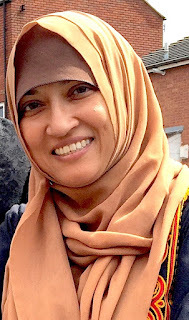 Fawzia Gilani-Williams
Fawzia Gilani-WilliamsFirst of all, there's the money. When you decide to split the writing of a book, your advance and your royalties are split as well. If the authors have different literary agents, their percentage is affected the same way, with an increase of time and effort on their parts--which means some agents might not want to represent a multiple-author project. And that's completely understandable. Fawzia and I decided that these obstacles would not stop us from writing and selling this book of our hearts, together. But for these reasons, it took us a long time to sell it.
The second thing about co-authoring is that it's simply not easy to collaborate on a creative project of any kind. And when you're separated by more than six thousand miles and eight time zones, the challenge looms even larger! With Fawzia in the United Arab Emirates and me in Boston, you can imagine that even the smallest interactions between us had significant lag time unless we planned very carefully.
Yet in spite of these challenges, we discovered that--as with most things in life--if you can make your individual needs secondary to the work, you can do almost anything together.
The process of co-authoring is a process of developing mutual trust. In the beginning, Fawzia and I hesitated to give input to each other that might in any way be interpreted as criticism. But little by little, we set aside the shyness as we fell into a rhythm of writing/ sharing/ rewriting/ sharing/ status assessment. The status assessment piece consisted simply of doing a check in on all that we'd done so far. Every single part of the book had to pass that check-in: "Where is the we in this part of the book?" If the we had been taken over by someone's individual voice, we went back to the table until we got it right.
And yes, it took years.
But the result, for us, was so worth it.
Since the very beginning of our collaboration, Fawzia and I knew that the representation of Sephardic Jewish and Muslim characters we provide in the book is important. Muslim and Jewish kids need to see themselves reflected in books, and we need to fill the gaps in knowledge about our cultures and belief practices that lead to prejudice in non-Jews and non-Muslims.
So, now that the book is hitting the shelves (April 1st!), it saddens us to realize our book's message of celebrating difference and fighting hate is more urgent than ever.
I'll leave you with something I like to tell students when I do class visits:
What we share, unites us.
Our differences excite us!
In the spirit of exciting differences...
Shalom, Salaam!
~
About the author: Bridget Hodder has decades of experience as a reading and communication specialist, working primarily with young people with learning disabilities. Like Ava in "The Button Box," Bridget is Sephardic. She is also the daughter and granddaughter of Holocaust survivors. Her first Middle Grade book, “The Rat Prince,” was published by Farrar, Straus & Giroux. “The Rat Prince” was an ILA -CBC Children's Choice List starred selection, an Amazon Hot List pick, and was a finalist for the Mythopoeic Society award in Children's Fantasy Literature. After the release of "The Button Box," Bridget and Fawzia's next co-written multicultural children's tale for Kar-Ben / Lerner Books will be published in 2023. To learn more about Bridget’s life and work, visit her website: http://bridgethodder.com/
April 3, 2022
The Vaccine for Racism
 Hello and Happy National Poetry Month!
Hello and Happy National Poetry Month!Last month I read a wonderful middle grade novel NEW FROM HERE by Kelly Yang. It's about a family living in Hong Kong at the start of the pandemic. I didn't think I'd ever want to ready any story set during the pandemic, but this one is unique...and also based on the author's real life experience.
Quote from the book: "The vaccine for racism is love."
I LOVE that! Don't you?
 With that in mind, here's a (skinny) poem to celebrate National Poetry Month from DICTIONARY FOR A BETTER WORLD: Poems, Quotes, & Anecdotes by Irene Latham and Charles Waters, illus. by Mehrdokht Amini (Carolrhoda/Lerner Publishing). Thanks so much for reading!
With that in mind, here's a (skinny) poem to celebrate National Poetry Month from DICTIONARY FOR A BETTER WORLD: Poems, Quotes, & Anecdotes by Irene Latham and Charles Waters, illus. by Mehrdokht Amini (Carolrhoda/Lerner Publishing). Thanks so much for reading!

Love
Love in the time of racism
requires
cardinal's
red
courage
requires
bluebird
carrying
sky
requires
love—no time for racism.
- Irene Latham
--
Irene Latham is a grateful creator of many novels, poetry collections, and picture books, including the coauthored Can I Touch Your Hair? Poems of Race, Mistakes, and Friendship, which earned a Charlotte Huck Honor, and The Cat Man of Aleppo, which won a Caldecott Honor. Irene lives on a lake in rural Alabama.April 2, 2022
A Sampling of New Middle Grade Literature
A Sampling of New Middle Grade Literature
This month our blog is focusing on the themes of fearlessness, impatience, and adventurousness, so I thought I’d highlight some great new middle grade books including these themes that I’ve featured recently on my other blog, Book Q&As with Deborah Kalb.

Alexandria Rogers’ new middle grade novel, The Witch, the Sword, and the Cursed Knights , focuses on two kids who end up in the midst of the legend of Camelot. “I wanted Camelot to have been real, and I wanted to see what the world would become if such a utopian kingdom fell,” she told me. “It made me ask more questions that excited me. Was it never truly that utopic to begin with? Who believed Camelot was the answer to their problems? Who believed King Arthur was their savior? Who didn't? Why?”
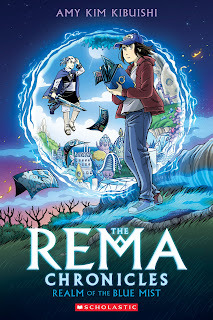
Amy Kim Kibuishi’s new MG graphic novel, The Rema Chronicles: Realm of the Blue Mist , is the first in a series. “Most of Rema is deeply inspired by events in my life and the landscape of my mother’s hometown of Chumunjin, South Korea, but I kept adding fun stuff, too,” she said. “Every time I was inspired by something – a good video game, a fantastic novel, or fun anime – it went into Rema’s development.”

Saadia Faruqi’s MG novel, Yusuf Azeem Is Not a Hero , tells the story of a Muslim American boy growing up in Texas. “In Yusuf, I wanted to create a character that was sweet, gentle, curious, and loving,” she said. “Unfortunately, Americans often have a very stereotypically negative image of Muslim males as unyielding and harsh and possibly even violent, and I yearned to shatter those stereotypes.”

And Jeannine Atkins’s new biographical work for upper MG readers, Hidden Powers , looks at the life of physicist Lise Meitner. “I think perhaps Lise Meitner’s greatest legacy was her refusal to work on the atomic bomb,” Atkins said. “Many of her peers, including Einstein, supported the bomb being built, and many, including Einstein, deeply regretted that support.”
I’m glad to share these interviews, and hope you take a further look at the books!
--Deborah Kalb
@font-face {font-family:"Cambria Math"; panose-1:2 4 5 3 5 4 6 3 2 4; mso-font-charset:0; mso-generic-font-family:roman; mso-font-pitch:variable; mso-font-signature:3 0 0 0 1 0;}@font-face {font-family:Calibri; panose-1:2 15 5 2 2 2 4 3 2 4; mso-font-charset:0; mso-generic-font-family:swiss; mso-font-pitch:variable; mso-font-signature:-536859905 -1073732485 9 0 511 0;}p.MsoNormal, li.MsoNormal, div.MsoNormal {mso-style-unhide:no; mso-style-qformat:yes; mso-style-parent:""; margin:0in; mso-pagination:widow-orphan; font-size:16.0pt; font-family:"Times New Roman",serif; mso-fareast-font-family:Calibri; mso-fareast-theme-font:minor-latin;}.MsoChpDefault {mso-style-type:export-only; mso-default-props:yes; font-size:16.0pt; mso-ansi-font-size:16.0pt; mso-bidi-font-size:16.0pt; mso-fareast-font-family:Calibri; mso-fareast-theme-font:minor-latin;}div.WordSection1 {page:WordSection1;}



